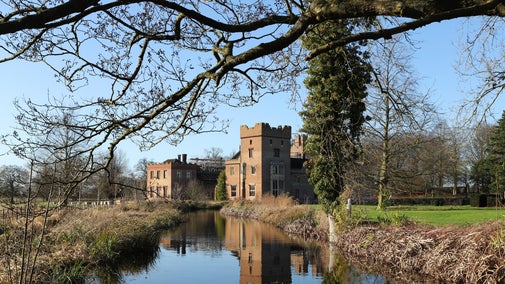
Donate
Everyone needs nature, now more than ever. Donate today and you could help people and nature to thrive at the places we care for.

The West Exmoor ranger team look after 1,200 acres of woodland, an area roughly the size of 16,000 tennis courts, containing around 400,000 trees. Rare species of moss, lichen and ground flora mean the woods have special protected status and form an important habitat for wildlife.
Most of the woodland on West Exmoor and around Watersmeet is known as semi-natural ancient woodland. This means that, although trees have often always been here, humans have played an important role in shaping the landscape we see today.
Large sections of our woods are the result of an industrial past which favoured oak trees, many of our woods were turned into monocultures of oak that were clear-felled on a 25-year cycle. Since ceasing extraction, these oaks have been allowed to get away, which is great in theory but has led to a lack diversity - both in species and structure.
Due to past management, we have ended up with an even age woodland with an excess of oak. Whilst these woods would normally have a high proportion of oak, the management of the past favoured oak to the point of cutting out other species - particularly the shrub layer.
Healthy woodlands depend on having a variety of age structures present, variety of species, and open spaces. To encourage this, saplings are given a chance by creating gaps in the woodland that allow new growth to take hold. At the same time, special older trees are identified and are given room to set seed and age.
The type of woodland management practised by the West Exmoor ranger team is known as Continuous Cover Forestry, which means there is never a time when large swathes of the woodland are felled. This focused conservation is done using several methods, which can be seen below.

A large part of our woodland management now revolves around creating new glades, as well as pollarding and coppicing areas.
There is an oak monoculture around both Heddon Valley and Watersmeet, where the trees are all a similar age and structure. By carrying out our woodland work we are encouraging diversity in the structure and creating new habitats for wildlife.
Glades are important areas for wildlife like birds and butterflies, and for light-loving plants. To create these gaps in the canopy we fell selected trees, which allows light to penetrate the canopy and reach the woodland floor. These can be between 0.25ha and 0.5ha in size.
Coppicing has similar benefits to pollarding, but also creates a variation in height within the woodland, again creating a diverse range of habitats for mammals and birds.
Pollarding is a traditional method of tree pruning where the tree's branches are cut back to encourage the growth of new shoots. The regrowth helps to create a diversity of habitats for birds, insects and small mammals like dormice. Pollarding trees allows more light to reach the forest floor and enables wildflowers and grasses to grow. The process also prolongs the tree's lifespan as the trunk and roots remain healthy.
Some of the timber we fell plays an important role in the sustainability of the places we care for. It is used in biomass boilers to heat buildings and can be milled up and used as ‘estate timber’ to make things like gates and fences. We only take a tiny proportion of wood out of our woodland and have a plan to make sure we only harvest sustainable amounts.

Sadly, many woodlands in North Devon are affected with ash dieback, a chronic fungal disease that affects our native ash trees. The disease severely weakens the tree structurally, meaning trees close to footpaths, roads and buildings can become extremely dangerous. We have been working to carefully manage and remove affected trees.ckson
Our team assesses the ash trees in critical locations and has planned for their safe removal. The ash trees that aren’t going to do any harm will be left alone to allow nature to take its course.
It is hoped that between one and five per cent of the ash trees we look after are resistant to the disease, making them the future of ash in the UK.
Download our woodland managment plan to find out more about the deer at West Exmoor and our work in this landscape.

Everyone needs nature, now more than ever. Donate today and you could help people and nature to thrive at the places we care for.
Explore the wooded river valley reaching inland down to the sea at Heddon's Mouth. Heddon Valley's walking routes include two accessible routes for all-terrain mobility scooters with Tramper.

Find out more about the history of The Hunters Inn and Woody Bay. Discover tales of fraud and fire and how the estate became increasingly popular with Victorian tourists.

Find out where to eat and drink in this wooded valley on Exmoor, from classic pub lunches in the historic Hunters Inn to takeaway food and ice cream from The Pantry.

Volunteers in North Devon play a big part in caring for over 8,000 acres of land, 50 miles of coastline and 101 miles of footpath. Discover how you can get involved.

There are two types of deer found on West Exmoor, the red deer and roe deer, both of which are native and a much-loved feature of Exmoor. Find out about their history and how they are managed.

We believe that nature, beauty and history are for everyone. That’s why we’re supporting wildlife, protecting historic sites and more. Find out about our work.

Read about our strategy, which focuses on restoring nature, ending unequal access and inspiring more people.

Newly sown wildflower grassland will connect nature habitats in the North Devon countryside. The project will see grassland cover 1,275 hectares over pockets of land across 70 miles by 2030, from Torridge to west Exmoor.